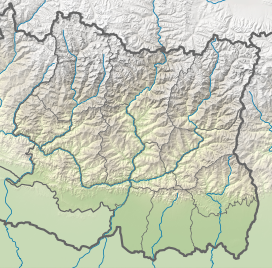Baruntse
This article needs additional citations for verification. (June 2011) |
| Baruntse | |
|---|---|
 Baruntse from Hongu Valley | |
| Highest point | |
| Elevation | 7,162 m (23,497 ft)[1] |
| Prominence | 979 m (3,212 ft)[1] |
| Coordinates | 27°52′18″N 86°58′48″E / 27.87167°N 86.98000°E |
| Geography | |
| Location | Khumbu, Nepal |
| Parent range | Himalayas |
| Climbing | |
| First ascent | 1954 by New Zealand expedition |
| Easiest route | glacier/snow/ice climb |
Baruntse is a mountain in the Khumbu region of eastern Nepal, crowned by four peaks and bounded on the south by the Hunku Glacier, on the east by the Barun Glacier, and on the northwest by the Imja Glacier. It is considered as one of the best preparation peaks in the Himalayas for climbers readying themselves for eight-thousanders, however the mountain has a low success rate due to its technical difficulties, steep slopes and unpredictable weather conditions.[2] It is open for beginners, but requires the use of fixed ropes to climb.[3]
Accessing the mountain is usually gained from the South, where climbers can ascend Mera Peak to acclimatize before moving up the valley to Baruntse base camp. From the village of Lukla, it is an eight day hike to base camp.[4]
First ascents
[edit]The mountain was first climbed May 30, 1954 via the south ridge by Colin Todd and Geoff Harrow of a New Zealand expedition led by Sir Edmund Hillary.[5]
The first ascent of the East Ridge was made on April 27, 1980 by Lorenzo Ortas, Javier Escartín, Jeronimo Lopez (all Spain) and Carlos Buhler (America) of a Spanish expedition led by Juan José Díaz Ibañez.[6]
In 1994, the first ascent of the North West face of Baruntse North by Vladimir Leitermann, Martin Otta and Tomas Pekarek was nominated for a Piolets d'Or.[7]
The first ascent of the west face was made in 1995 by a Russian team consisting of climbers Valeri Pershin (climbing leader), Evgeni Vinogradski, Salavat Habibulin, Nikolai Zhilin, and Yuri Ermachek. The ascent was made in seven days and the summit was made on October 12.[4]
In 2004, the first ascent of Ciao Patrick (V+/VI M6+ 90°) on the northwest face and northwest ridge of Baruntse North (7,057m) was made by Simone Moro, Bruno Tassi and Denis Urubko. The alpine-style ascent was identified as one of the most notable ascents of the year.[8]
In 2010, Becky Bellworthy from the United Kingdom became the youngest woman to summit Baruntse at 18 years old.[9]
Notable climbs and incidents
[edit]In 1998, prominent American alpinist and ski racer Raoul Wille died of altitude sickness while climbing Baruntse.[10][11]
Nineteen-times Everest summiteer Chhewang Nima died in 2010 on Baruntse[12] after falling through a cornice while fixing a rope beneath the summit.[13]
In 2013, Petr Machold and Jakub Vaněk from the Czech Republic were lost after attempting to climb up the mountain's west side, which had only been done once previously. They made it to 6,600m. Heavy snow caught them in camp, and when a rescue operation was mounted, the climbers could not be found.[14]
In 2018, Mera, a stray Tibetan mastiff-Himalayan sheepdog cross climbed Baruntse after following a trekking expedition up the mountain. Team leader Don Wargowsky shared his tent and a sleeping mat with the dog, who is thought to be the first canine to ascend a 7,000m peak.[15][3]
In 2021, Czech climbers Marek Holeček and Radek “Ráďa” Groh attempted the North-West face climb that had caught Machold and Vaněk eight years earlier.[16] The perilous climb, which they later named "Heavenly Trap", lasted ten days due to increasingly worsening weather conditions. After summitting, the descent took nearly 80 hours.[17] The climbers graded the route VI+ M6+ 80°.[18]
References
[edit]- ^ a b "Baruntse, Nepal" Peakbagger.com. Retrieved 2012-01-22.
- ^ "Three climbers scale Mt Baruntse with Seven Summit Treks". The Himalayan Times. 2023-11-03. Retrieved 2024-06-27.
- ^ a b Callaghan, Anna (2019-03-03). "The First Canine Ascent of a 7,000-Meter Himalayan Peak". Outside Online. Retrieved 2024-06-27.
- ^ a b Efimov, Sergei (1995). "AAC Publications - Baruntse, West Face, Historical Ascent". publications.americanalpineclub.org. Retrieved 2024-06-27.
- ^ Hillary, E.; Hardie, N.; Harrow, G.; Ball, M.; Todd, C. (1955). "The N.Z.A.C. Himalayan Expedition, 1954". New Zealand Alpine Journal: 5–53. Archived from the original on February 18, 2013. Retrieved November 25, 2012.
- ^ Díaz Ibañez, Juan José (1983). Expedición Aragonesa al Himalaya Baruntse (7220). Zaragoza, Aragon, Spain: Caja de Ahorros y Monte de Piedad de Zaragoza, Aragon y Rioja. ISBN 8450083397.
- ^ "Piolets d'Or - 1992 - 2021". pioletsdor.net. Retrieved 2024-06-27.
- ^ "Piolets d'Or - 1992 - 2021". pioletsdor.net. Retrieved 2024-06-27.
- ^ Gardner, Tina (December 19, 2010). "Becky climbs into the record books". www.thebmc.co.uk. Retrieved 2024-06-27.
- ^ "Raoul Wille Memorial - Mount Raoul". www.mountraoul.org. Retrieved 2024-06-27.
- ^ "The Himalayan Database Online". The Himalayan Database. Ann Arbor, Michigan. Retrieved June 27, 2024.
- ^ "Search for missing Nepal Sherpa Chhewang Nima stopped". BBC News. Retrieved 1 September 2015.
- ^ "The Disposable Man: A Western History of Sherpas on Everest". Outside magazine. 6 March 2020.
- ^ Volynsky, Masha (2013-10-21). "Two Czechs missing in the Himalayas". Radio Prague International. Retrieved 2024-06-27.
- ^ Cockburn, Harry (2019-03-07). "Stray dog follows climbing expedition to become first to reach Himalayan summit". The Independent. Retrieved 2024-06-27.
- ^ "Watch Márek Holeček, Radoslav Groh establish Heavenly Trap on Baruntse". PlanetMountain.com. Retrieved 2024-06-27.
- ^ "Márek Holeček, Radoslav Groh survive Baruntse NW Face ordeal". PlanetMountain.com. Retrieved 2024-06-27.
- ^ Holeček, Markek (2022). "AAC Publications - Baruntse, West Face, Heavenly Trap". publications.americanalpineclub.org. Retrieved 2024-06-27.


